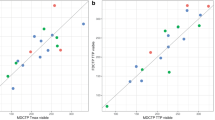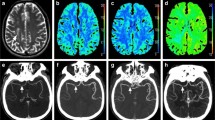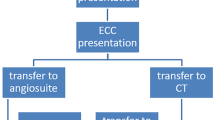Abstract
Introduction
Perfusion computed tomography (PCT) is increasingly performed in multimodal CT evaluation of acute ischemic stroke. We compared the technical quality of perfusion studies performed with a 16-row and a 64-row scanner and analyzed the differences between the scanners in their ability to detect perfusion defects.
Methods
We analyzed retrospectively the clinical and imaging data of 140 consecutive acute (<3 h) stroke patients who underwent multimodal CT evaluation and received intravenous rtPA. Alberta Stroke Program Early CT Score (ASPECTS) was assigned to PCT maps. Clinical and imaging parameters were compared between the two scanners.
Results
There were more motion artifacts in the 16-row studies (p = 0.04), and the analysis software was able to completely correct significantly fewer of these (p < 0.001). Both ASPECTS levels were optimally covered in only 29% of the 16-row studies, whereas in the 64-row studies, both levels were invariably optimally visualized (p < 0.001). This significantly decreased the sensitivity of the 16-row scanner to detect perfusion defects in the upper ASPECTS level (p = 0.02). The 64-row scanner was able to detect more perfusion defects that were located entirely outside the ASPECTS regions (p = 0.03). There was no significant difference in the 3-month functional outcome.
Conclusions
The 16-row scanner suffered from limited anatomic coverage that decreased the sensitivity to detect perfusion defects in the cranial parts of the middle cerebral artery region. The 16-row studies had poorer technical quality that was in part attributable to higher sampling frequency and smaller slice thickness making the imaging more sensitive to small-scale movement of the patient.

Similar content being viewed by others
Abbreviations
- AIF:
-
Arterial input function
- ASPECTS:
-
Alberta Stroke Program Early CT Score
- CBV:
-
Cerebral blood volume
- MCA:
-
Middle cerebral artery
- MRI:
-
Magnetic resonance imaging
- MTT:
-
Mean transit time
- NCCT:
-
Non-contrast-enhanced computed tomography
- NIHSS:
-
National Institutes of Health Stroke Scale
- mRS:
-
Modified Rankin Scale
- PCT:
-
Perfusion computed tomography
- rtPA:
-
Recombinant tissue plasminogen activator
- VOF:
-
Venous output function
References
Obach V, Oleaga L, Urra X et al (2011) Multimodal CT-assisted thrombolysis in patients with acute stroke: a cohort study. Stroke 42:1129–1131
Hacke W, Albers G, Al-Rawi Y et al (2005) The Desmoteplase in Acute Ischemic Stroke Trial (DIAS): a phase II MRI-based 9-hour window acute stroke thrombolysis trial with intravenous desmoteplase. Stroke 36:66–73
Albers GW, Thijs VN, Wechsler L et al (2006) Magnetic resonance imaging profiles predict clinical response to early reperfusion: the diffusion and perfusion imaging evaluation for understanding stroke evolution (DEFUSE) study. Ann Neurol 60:508–517
Davis SM, Donnan GA, Parsons MW et al (2008) Effects of alteplase beyond 3 h after stroke in the Echoplanar Imaging Thrombolytic Evaluation Trial (EPITHET): a placebo-controlled randomised trial. Lancet Neurol 7:299–309
Barber PA, Hill MD, Eliasziw M et al (2005) Imaging of the brain in acute ischaemic stroke: comparison of computed tomography and magnetic resonance diffusion-weighted imaging. J Neurol Neurosurg Psychiatry 76:1528–1533
Rai AT, Carpenter JS, Peykanu JA et al (2008) The role of CT perfusion imaging in acute stroke diagnosis: a large single-center experience. J Emerg Med 35:287–292
Schramm P, Schellinger PD, Klotz E et al (2004) Comparison of perfusion computed tomography and computed tomography angiography source images with perfusion-weighted imaging and diffusion-weighted imaging in patients with acute stroke of less than 6 hours’ duration. Stroke 35:1652–1658
Wintermark M, Meuli R, Browaeys P et al (2007) Comparison of CT perfusion and angiography and MRI in selecting stroke patients for acute treatment. Neurology 68:694–697
Wintermark M, Reichhart M, Cuisenaire O et al (2002) Comparison of admission perfusion computed tomography and qualitative diffusion- and perfusion-weighted magnetic resonance imaging in acute stroke patients. Stroke 33:2025–2031
Na DG, Ryoo JW, Lee KH et al (2003) Multiphasic perfusion computed tomography in hyperacute ischemic stroke: comparison with diffusion and perfusion magnetic resonance imaging. J Comput Assist Tomogr 27:194–206
Lin K, Rapalino O, Law M et al (2008) Accuracy of the Alberta Stroke Program Early CT Score during the first 3 hours of middle cerebral artery stroke: comparison of noncontrast CT, CT angiography source images, and CT perfusion. AJNR Am J Neuroradiol 29:931–936
Eckert B, Küsel T, Leppien A et al (2010) Clinical outcome and imaging follow-up in acute stroke patients with normal perfusion CT and normal CT angiography. Neuroradiology 53:79–88
Dorn F, Muenzel D, Meier R et al (2011) Brain perfusion CT for acute stroke using a 256-slice CT: improvement of diagnostic information by large volume coverage. Eur Radiol 21:1803–1810
Pexman JH, Barber PA, Hill MD et al (2001) Use of the Alberta Stroke Program Early CT Score (ASPECTS) for assessing CT scans in patients with acute stroke. AJNR Am J Neuroradiol 22:1534–1542
Sillanpaa N, Saarinen JT, Rusanen H et al (2011) CT perfusion ASPECTS in the evaluation of acute ischemic stroke: thrombolytic therapy perspective. Cerebrovasc Dis Extra 1:6–16
Furtado AD, Lau BC, Vittinghoff E et al (2010) Optimal brain perfusion CT coverage in patients with acute middle cerebral artery stroke. AJNR Am J Neuroradiol 31:691–695
Page M, Nandurkar D, Crossett MP et al (2010) Comparison of 4 cm Z-axis and 16 cm Z-axis multidetector CT perfusion. Eur Radiol 20:1508–1514
Morhard D, Wirth CD, Fesl G et al (2010) Advantages of extended brain perfusion computed tomography: 9.6 cm coverage with time resolved computed tomography-angiography in comparison to standard stroke-computed tomography. Invest Radiol 45:363–369
Youn SW, Kim JH, Weon YC et al (2008) Perfusion CT of the brain using 40-mm-wide detector and toggling table technique for initial imaging of acute stroke. AJR Am J Roentgenol 191:W120–W126
Acknowledgments
This study was supported by the Tampere University Hospital governmental subsidiary (EVO) funds for clinical research.
Conflict of interest
We declare that we have no conflict of interest.
Author information
Authors and Affiliations
Corresponding author
Rights and permissions
About this article
Cite this article
Sillanpaa, N., Rusanen, H., Saarinen, J.T. et al. Comparison of 64-row and 16-row multidetector CT in the perfusion CT evaluation of acute ischemic stroke patients receiving intravenous thrombolytic therapy. Neuroradiology 54, 957–963 (2012). https://doi.org/10.1007/s00234-012-1015-y
Received:
Accepted:
Published:
Issue Date:
DOI: https://doi.org/10.1007/s00234-012-1015-y




